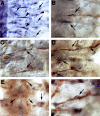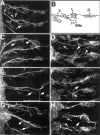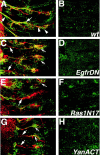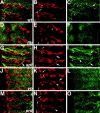Reciprocal interactions between neurons and glia are required for Drosophila peripheral nervous system development
- PMID: 12967983
- PMCID: PMC6740693
- DOI: 10.1523/JNEUROSCI.23-23-08221.2003
Reciprocal interactions between neurons and glia are required for Drosophila peripheral nervous system development
Abstract
A major developmental role of peripheral glia is to mediate sensory axon guidance; however, it is not known whether sensory neurons influence peripheral glial development. To determine whether glia and neurons reciprocally interact during embryonic development, we ablated each cell type by overexpressing the apoptosis gene, grim, and observed the effects on peripheral nervous system (PNS) development. When neurons are ablated, glial defects occur as a secondary effect, and vice versa. Therefore glia and neurons are codependent during embryogenesis. To further explore glial-neuronal interactions, we genetically disrupted glial migration or differentiation and observed the secondary effects on sensory neuron development. Glial migration and ensheathment of PNS axons was blocked by overexpression of activated Rho GTPase, a regulator of actin dynamics. Here, sensory axons extended to the CNS without exhibiting gross pathfinding errors. In contrast, disrupting differentiation by expression of dominant-negative Ras GTPase in glia resulted in major sensory axon pathfinding errors, similar to those seen in glial ablations. Glial overexpression of transgenic components of the epidermal growth factor receptor (EGFR) signaling pathway yielded similar sensory neuron defects and also downregulated the expression of the glial marker Neuroglian. Mutant analysis also suggested that the EGFR ligands Spitz and Vein play roles in peripheral glial development. The observations support a model in which glia express genes necessary for sensory neuron development, and these genes are potentially under the control of the EGFR/Ras signaling pathway.
Figures







Similar articles
-
Peripheral glia direct axon guidance across the CNS/PNS transition zone.Dev Biol. 2001 Oct 1;238(1):47-63. doi: 10.1006/dbio.2001.0411. Dev Biol. 2001. PMID: 11783993
-
Axonal wrapping in the Drosophila PNS is controlled by glia-derived neuregulin homolog Vein.Development. 2015 Apr 1;142(7):1336-45. doi: 10.1242/dev.116616. Epub 2015 Mar 10. Development. 2015. PMID: 25758464
-
Intrinsic dorsoventral patterning and extrinsic EGFR signaling genes control glial cell development in the Drosophila nervous system.Neuroscience. 2015 Oct 29;307:242-52. doi: 10.1016/j.neuroscience.2015.08.049. Epub 2015 Aug 28. Neuroscience. 2015. PMID: 26318336
-
Signaling in glial development: differentiation migration and axon guidance.Biochem Cell Biol. 2004 Dec;82(6):694-707. doi: 10.1139/o04-119. Biochem Cell Biol. 2004. PMID: 15674437 Review.
-
The role of glial cells in axon guidance, fasciculation and targeting.Adv Exp Med Biol. 2007;621:156-66. doi: 10.1007/978-0-387-76715-4_12. Adv Exp Med Biol. 2007. PMID: 18269218 Review.
Cited by
-
Drosophila MMP2 regulates the matrix molecule faulty attraction (Frac) to promote motor axon targeting in Drosophila.J Neurosci. 2011 Apr 6;31(14):5335-47. doi: 10.1523/JNEUROSCI.4811-10.2011. J Neurosci. 2011. PMID: 21471368 Free PMC article.
-
Murine glial protrusion transcripts predict localized Drosophila glial mRNAs involved in plasticity.J Cell Biol. 2024 Oct 7;223(10):e202306152. doi: 10.1083/jcb.202306152. Epub 2024 Jul 22. J Cell Biol. 2024. PMID: 39037431 Free PMC article.
-
Drosophila glial glutamate transporter Eaat1 is regulated by fringe-mediated notch signaling and is essential for larval locomotion.J Neurosci. 2010 Oct 27;30(43):14446-57. doi: 10.1523/JNEUROSCI.1021-10.2010. J Neurosci. 2010. PMID: 20980602 Free PMC article.
-
EGFR and FGFR pathways have distinct roles in Drosophila mushroom body development and ethanol-induced behavior.PLoS One. 2014 Jan 31;9(1):e87714. doi: 10.1371/journal.pone.0087714. eCollection 2014. PLoS One. 2014. PMID: 24498174 Free PMC article.
-
Localized netrins act as positional cues to control layer-specific targeting of photoreceptor axons in Drosophila.Neuron. 2012 Jul 12;75(1):80-93. doi: 10.1016/j.neuron.2012.04.037. Neuron. 2012. PMID: 22794263 Free PMC article.
References
-
- Auld VJ, Fetter RD, Broadie K, Goodman CS ( 1995) Gliotactin, a novel transmembrane protein on peripheral glia, is required to form the blood-nerve barrier in Drosophila Cell 81 : 757-767. - PubMed
-
- Bergmann A, Tugentman M, Shilo B-Z, Steller H ( 2002) Regulation of cell number by MAPK-dependent control of apoptosis: a mechanism for trophic survival signaling. Dev Cell 2 : 159-170. - PubMed
-
- Bieber AJ, Snow PM, Hortsch M, Patel NH, Jacobs JR, Traquina ZR, Schilling J, Goodman CS ( 1989) Drosophila Neuroglian: a member of the immunoglobulin superfamily with extensive homology to the vertebrate neural adhesion molecule L1. Cell 59 : 447-460. - PubMed
-
- Booth GE, Kinrade EFV, Hidalgo A ( 2000) Glia maintain follower neuron survival during Drosophila CNS development. Development 127 : 237-244. - PubMed
Publication types
MeSH terms
Substances
LinkOut - more resources
Full Text Sources
Molecular Biology Databases
Research Materials
Miscellaneous
